Commercial Cookery - Assessment 1: Workplace Safety and Hazards
VerifiedAdded on 2022/11/13
|32
|4768
|136
Homework Assignment
AI Summary
This document presents a comprehensive solution for Commercial Cookery Assessment 1, addressing various aspects of workplace safety and hazard management. The assignment covers topics such as identifying workplace hazards, assessing and controlling risks, and understanding WHS legislation. It includes detailed answers to questions related to physical, chemical, ergonomic, biological, and psychological hazards. The solution also delves into hazard control methods, risk assessment processes, and the hierarchy of hazard control. Furthermore, the document provides insights into specific hazards in the hospitality industry, the importance of chemical handling, and the minimization of ergonomic and biological hazards. The assignment also explores the role of WHS committees, health and safety representatives, and the tools and templates used in risk assessment. Overall, the document offers a valuable resource for students studying commercial cookery, providing a thorough understanding of workplace safety principles and practices.
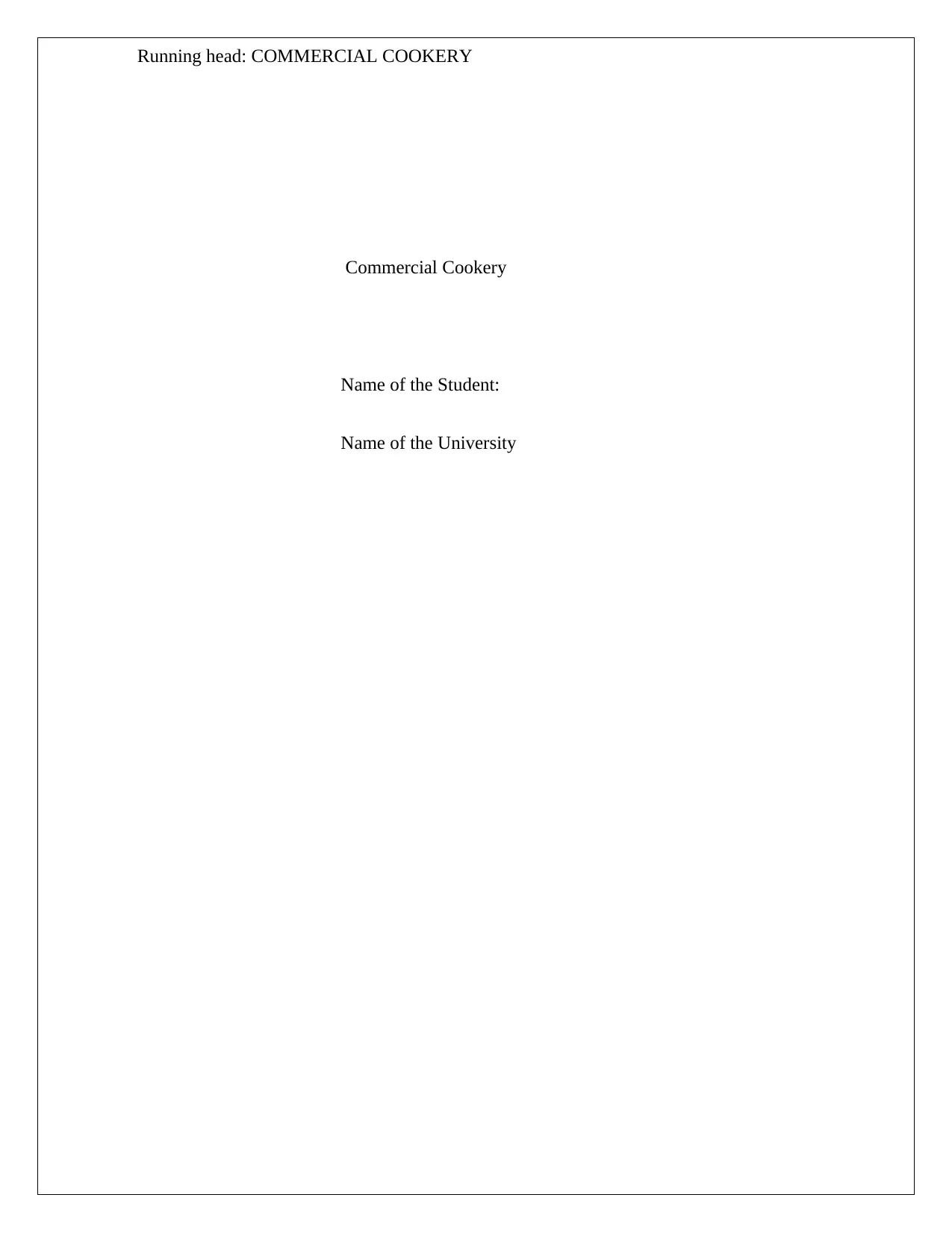
Running head: COMMERCIAL COOKERY
Commercial Cookery
Name of the Student:
Name of the University
Commercial Cookery
Name of the Student:
Name of the University
Paraphrase This Document
Need a fresh take? Get an instant paraphrase of this document with our AI Paraphraser
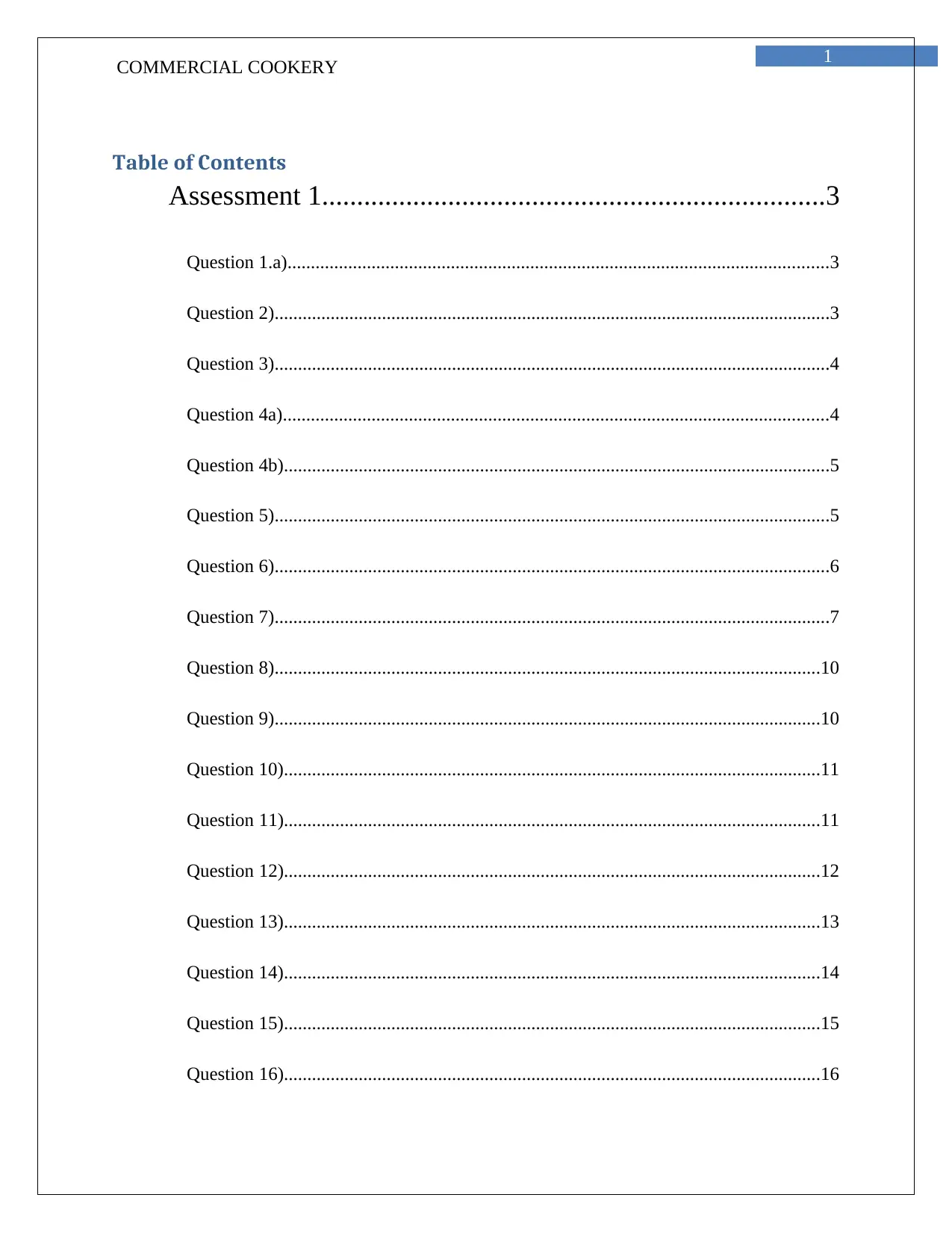
1
COMMERCIAL COOKERY
Table of Contents
Assessment 1........................................................................3
Question 1.a)....................................................................................................................3
Question 2).......................................................................................................................3
Question 3).......................................................................................................................4
Question 4a).....................................................................................................................4
Question 4b).....................................................................................................................5
Question 5).......................................................................................................................5
Question 6).......................................................................................................................6
Question 7).......................................................................................................................7
Question 8).....................................................................................................................10
Question 9).....................................................................................................................10
Question 10)...................................................................................................................11
Question 11)...................................................................................................................11
Question 12)...................................................................................................................12
Question 13)...................................................................................................................13
Question 14)...................................................................................................................14
Question 15)...................................................................................................................15
Question 16)...................................................................................................................16
COMMERCIAL COOKERY
Table of Contents
Assessment 1........................................................................3
Question 1.a)....................................................................................................................3
Question 2).......................................................................................................................3
Question 3).......................................................................................................................4
Question 4a).....................................................................................................................4
Question 4b).....................................................................................................................5
Question 5).......................................................................................................................5
Question 6).......................................................................................................................6
Question 7).......................................................................................................................7
Question 8).....................................................................................................................10
Question 9).....................................................................................................................10
Question 10)...................................................................................................................11
Question 11)...................................................................................................................11
Question 12)...................................................................................................................12
Question 13)...................................................................................................................13
Question 14)...................................................................................................................14
Question 15)...................................................................................................................15
Question 16)...................................................................................................................16
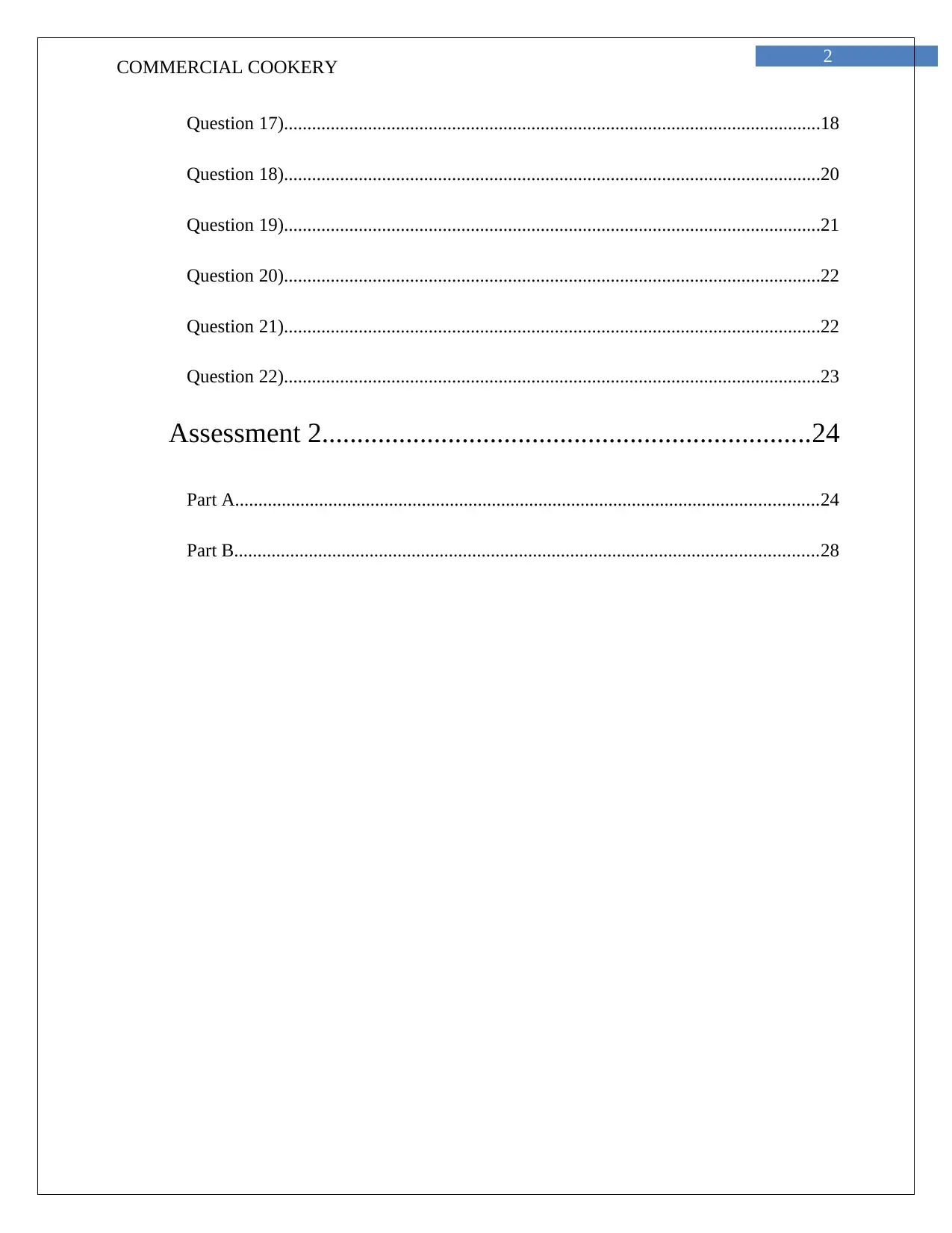
2
COMMERCIAL COOKERY
Question 17)...................................................................................................................18
Question 18)...................................................................................................................20
Question 19)...................................................................................................................21
Question 20)...................................................................................................................22
Question 21)...................................................................................................................22
Question 22)...................................................................................................................23
Assessment 2......................................................................24
Part A.............................................................................................................................24
Part B.............................................................................................................................28
COMMERCIAL COOKERY
Question 17)...................................................................................................................18
Question 18)...................................................................................................................20
Question 19)...................................................................................................................21
Question 20)...................................................................................................................22
Question 21)...................................................................................................................22
Question 22)...................................................................................................................23
Assessment 2......................................................................24
Part A.............................................................................................................................24
Part B.............................................................................................................................28
⊘ This is a preview!⊘
Do you want full access?
Subscribe today to unlock all pages.

Trusted by 1+ million students worldwide
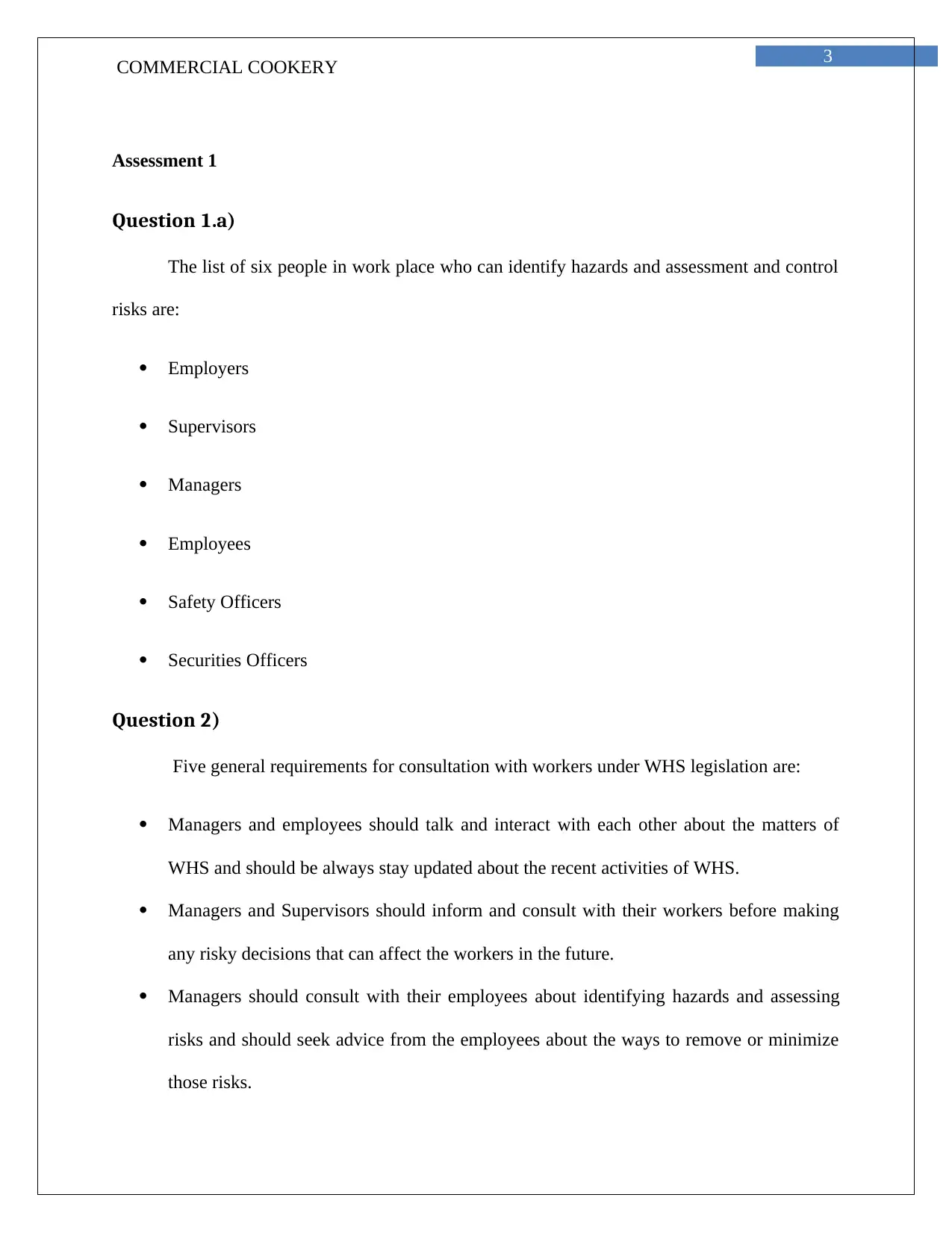
3
COMMERCIAL COOKERY
Assessment 1
Question 1.a)
The list of six people in work place who can identify hazards and assessment and control
risks are:
Employers
Supervisors
Managers
Employees
Safety Officers
Securities Officers
Question 2)
Five general requirements for consultation with workers under WHS legislation are:
Managers and employees should talk and interact with each other about the matters of
WHS and should be always stay updated about the recent activities of WHS.
Managers and Supervisors should inform and consult with their workers before making
any risky decisions that can affect the workers in the future.
Managers should consult with their employees about identifying hazards and assessing
risks and should seek advice from the employees about the ways to remove or minimize
those risks.
COMMERCIAL COOKERY
Assessment 1
Question 1.a)
The list of six people in work place who can identify hazards and assessment and control
risks are:
Employers
Supervisors
Managers
Employees
Safety Officers
Securities Officers
Question 2)
Five general requirements for consultation with workers under WHS legislation are:
Managers and employees should talk and interact with each other about the matters of
WHS and should be always stay updated about the recent activities of WHS.
Managers and Supervisors should inform and consult with their workers before making
any risky decisions that can affect the workers in the future.
Managers should consult with their employees about identifying hazards and assessing
risks and should seek advice from the employees about the ways to remove or minimize
those risks.
Paraphrase This Document
Need a fresh take? Get an instant paraphrase of this document with our AI Paraphraser
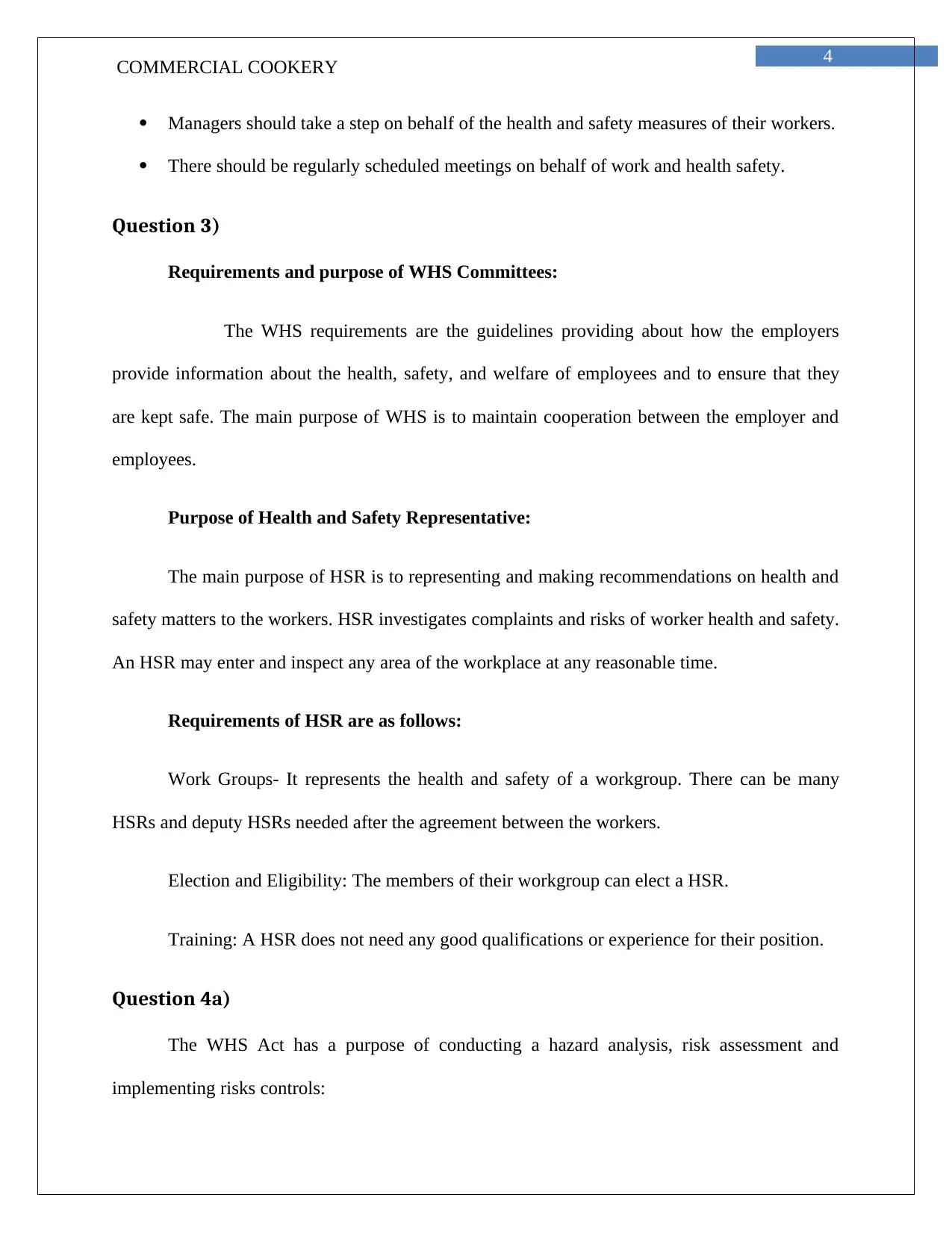
4
COMMERCIAL COOKERY
Managers should take a step on behalf of the health and safety measures of their workers.
There should be regularly scheduled meetings on behalf of work and health safety.
Question 3)
Requirements and purpose of WHS Committees:
The WHS requirements are the guidelines providing about how the employers
provide information about the health, safety, and welfare of employees and to ensure that they
are kept safe. The main purpose of WHS is to maintain cooperation between the employer and
employees.
Purpose of Health and Safety Representative:
The main purpose of HSR is to representing and making recommendations on health and
safety matters to the workers. HSR investigates complaints and risks of worker health and safety.
An HSR may enter and inspect any area of the workplace at any reasonable time.
Requirements of HSR are as follows:
Work Groups- It represents the health and safety of a workgroup. There can be many
HSRs and deputy HSRs needed after the agreement between the workers.
Election and Eligibility: The members of their workgroup can elect a HSR.
Training: A HSR does not need any good qualifications or experience for their position.
Question 4a)
The WHS Act has a purpose of conducting a hazard analysis, risk assessment and
implementing risks controls:
COMMERCIAL COOKERY
Managers should take a step on behalf of the health and safety measures of their workers.
There should be regularly scheduled meetings on behalf of work and health safety.
Question 3)
Requirements and purpose of WHS Committees:
The WHS requirements are the guidelines providing about how the employers
provide information about the health, safety, and welfare of employees and to ensure that they
are kept safe. The main purpose of WHS is to maintain cooperation between the employer and
employees.
Purpose of Health and Safety Representative:
The main purpose of HSR is to representing and making recommendations on health and
safety matters to the workers. HSR investigates complaints and risks of worker health and safety.
An HSR may enter and inspect any area of the workplace at any reasonable time.
Requirements of HSR are as follows:
Work Groups- It represents the health and safety of a workgroup. There can be many
HSRs and deputy HSRs needed after the agreement between the workers.
Election and Eligibility: The members of their workgroup can elect a HSR.
Training: A HSR does not need any good qualifications or experience for their position.
Question 4a)
The WHS Act has a purpose of conducting a hazard analysis, risk assessment and
implementing risks controls:
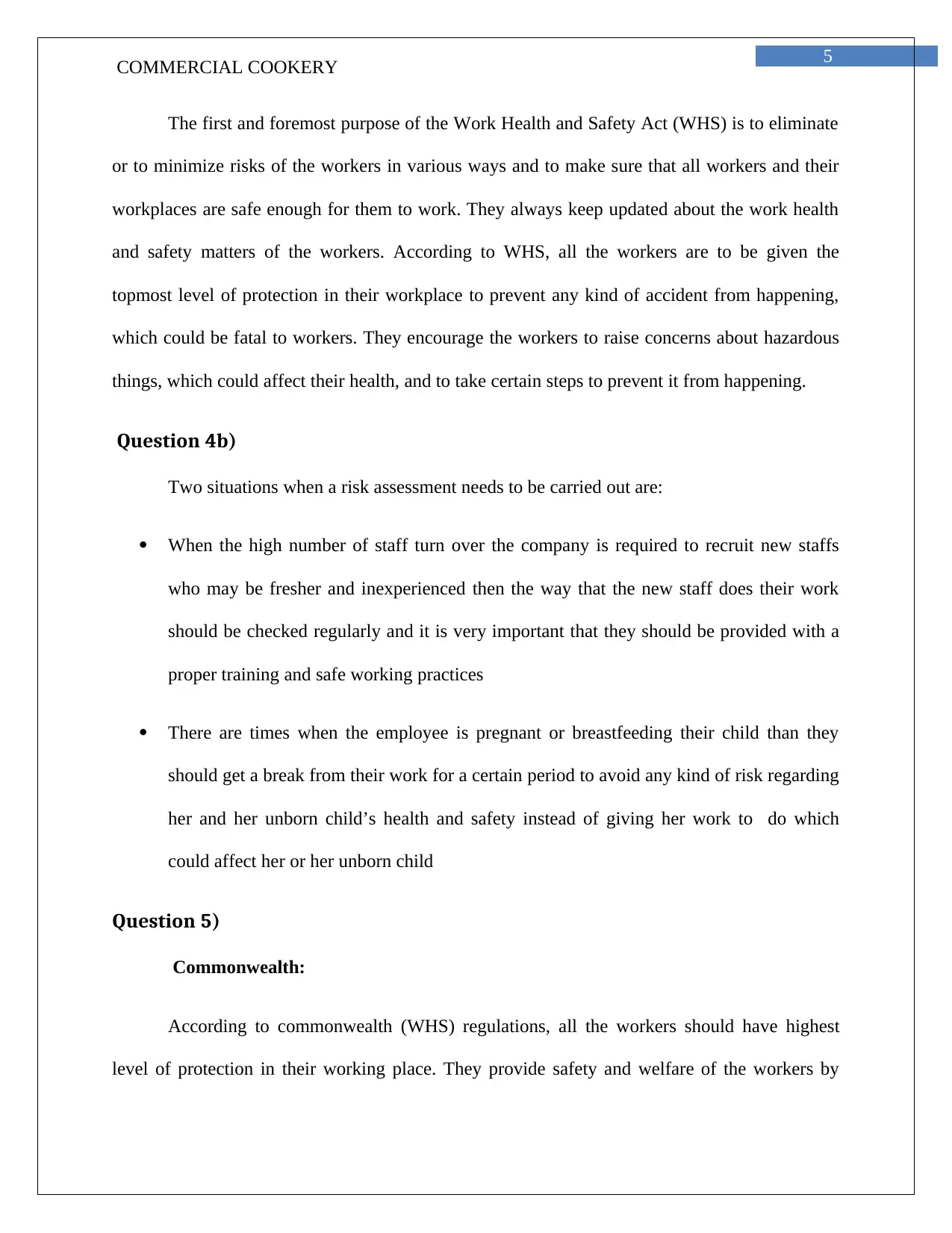
5
COMMERCIAL COOKERY
The first and foremost purpose of the Work Health and Safety Act (WHS) is to eliminate
or to minimize risks of the workers in various ways and to make sure that all workers and their
workplaces are safe enough for them to work. They always keep updated about the work health
and safety matters of the workers. According to WHS, all the workers are to be given the
topmost level of protection in their workplace to prevent any kind of accident from happening,
which could be fatal to workers. They encourage the workers to raise concerns about hazardous
things, which could affect their health, and to take certain steps to prevent it from happening.
Question 4b)
Two situations when a risk assessment needs to be carried out are:
When the high number of staff turn over the company is required to recruit new staffs
who may be fresher and inexperienced then the way that the new staff does their work
should be checked regularly and it is very important that they should be provided with a
proper training and safe working practices
There are times when the employee is pregnant or breastfeeding their child than they
should get a break from their work for a certain period to avoid any kind of risk regarding
her and her unborn child’s health and safety instead of giving her work to do which
could affect her or her unborn child
Question 5)
Commonwealth:
According to commonwealth (WHS) regulations, all the workers should have highest
level of protection in their working place. They provide safety and welfare of the workers by
COMMERCIAL COOKERY
The first and foremost purpose of the Work Health and Safety Act (WHS) is to eliminate
or to minimize risks of the workers in various ways and to make sure that all workers and their
workplaces are safe enough for them to work. They always keep updated about the work health
and safety matters of the workers. According to WHS, all the workers are to be given the
topmost level of protection in their workplace to prevent any kind of accident from happening,
which could be fatal to workers. They encourage the workers to raise concerns about hazardous
things, which could affect their health, and to take certain steps to prevent it from happening.
Question 4b)
Two situations when a risk assessment needs to be carried out are:
When the high number of staff turn over the company is required to recruit new staffs
who may be fresher and inexperienced then the way that the new staff does their work
should be checked regularly and it is very important that they should be provided with a
proper training and safe working practices
There are times when the employee is pregnant or breastfeeding their child than they
should get a break from their work for a certain period to avoid any kind of risk regarding
her and her unborn child’s health and safety instead of giving her work to do which
could affect her or her unborn child
Question 5)
Commonwealth:
According to commonwealth (WHS) regulations, all the workers should have highest
level of protection in their working place. They provide safety and welfare of the workers by
⊘ This is a preview!⊘
Do you want full access?
Subscribe today to unlock all pages.

Trusted by 1+ million students worldwide
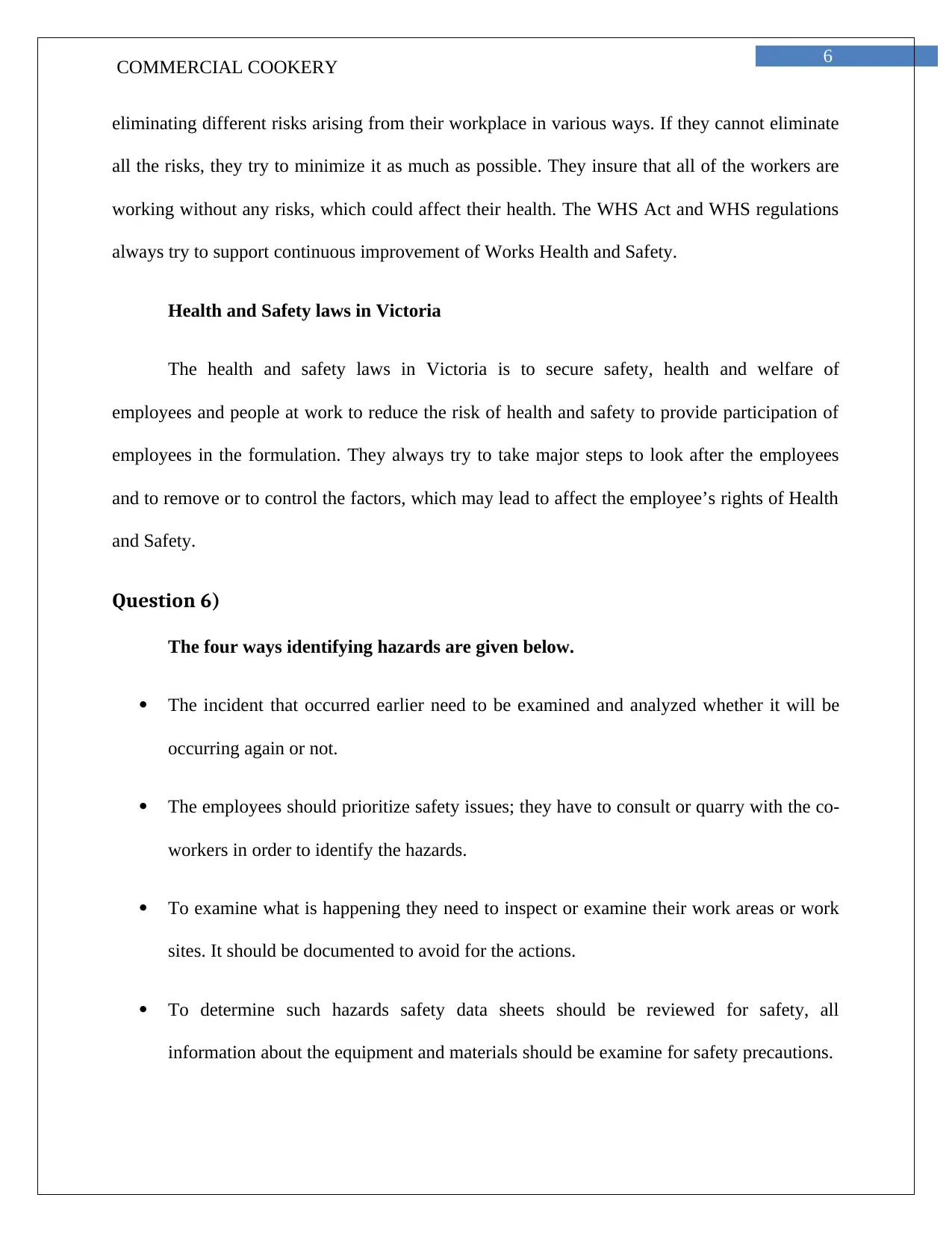
6
COMMERCIAL COOKERY
eliminating different risks arising from their workplace in various ways. If they cannot eliminate
all the risks, they try to minimize it as much as possible. They insure that all of the workers are
working without any risks, which could affect their health. The WHS Act and WHS regulations
always try to support continuous improvement of Works Health and Safety.
Health and Safety laws in Victoria
The health and safety laws in Victoria is to secure safety, health and welfare of
employees and people at work to reduce the risk of health and safety to provide participation of
employees in the formulation. They always try to take major steps to look after the employees
and to remove or to control the factors, which may lead to affect the employee’s rights of Health
and Safety.
Question 6)
The four ways identifying hazards are given below.
The incident that occurred earlier need to be examined and analyzed whether it will be
occurring again or not.
The employees should prioritize safety issues; they have to consult or quarry with the co-
workers in order to identify the hazards.
To examine what is happening they need to inspect or examine their work areas or work
sites. It should be documented to avoid for the actions.
To determine such hazards safety data sheets should be reviewed for safety, all
information about the equipment and materials should be examine for safety precautions.
COMMERCIAL COOKERY
eliminating different risks arising from their workplace in various ways. If they cannot eliminate
all the risks, they try to minimize it as much as possible. They insure that all of the workers are
working without any risks, which could affect their health. The WHS Act and WHS regulations
always try to support continuous improvement of Works Health and Safety.
Health and Safety laws in Victoria
The health and safety laws in Victoria is to secure safety, health and welfare of
employees and people at work to reduce the risk of health and safety to provide participation of
employees in the formulation. They always try to take major steps to look after the employees
and to remove or to control the factors, which may lead to affect the employee’s rights of Health
and Safety.
Question 6)
The four ways identifying hazards are given below.
The incident that occurred earlier need to be examined and analyzed whether it will be
occurring again or not.
The employees should prioritize safety issues; they have to consult or quarry with the co-
workers in order to identify the hazards.
To examine what is happening they need to inspect or examine their work areas or work
sites. It should be documented to avoid for the actions.
To determine such hazards safety data sheets should be reviewed for safety, all
information about the equipment and materials should be examine for safety precautions.
Paraphrase This Document
Need a fresh take? Get an instant paraphrase of this document with our AI Paraphraser
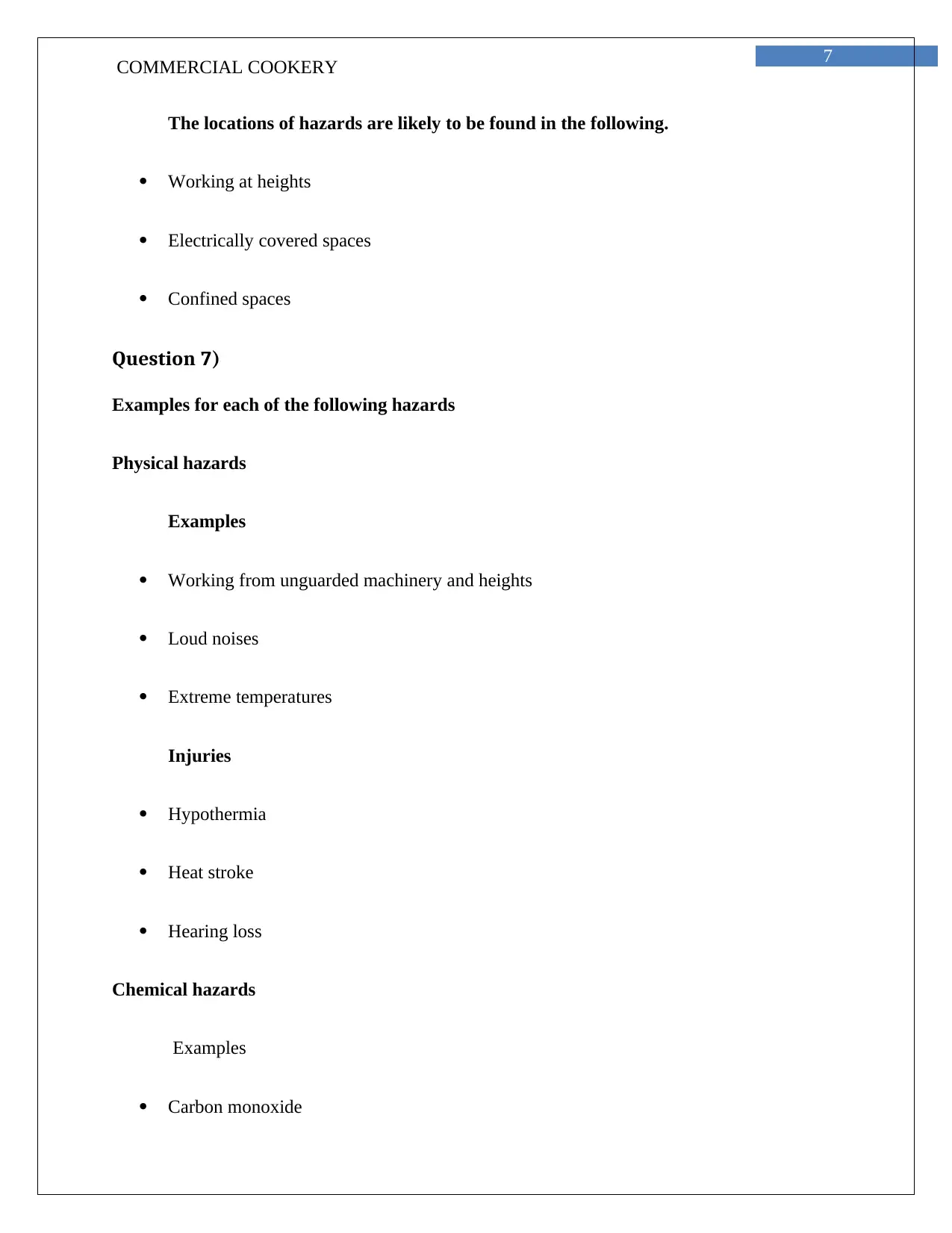
7
COMMERCIAL COOKERY
The locations of hazards are likely to be found in the following.
Working at heights
Electrically covered spaces
Confined spaces
Question 7)
Examples for each of the following hazards
Physical hazards
Examples
Working from unguarded machinery and heights
Loud noises
Extreme temperatures
Injuries
Hypothermia
Heat stroke
Hearing loss
Chemical hazards
Examples
Carbon monoxide
COMMERCIAL COOKERY
The locations of hazards are likely to be found in the following.
Working at heights
Electrically covered spaces
Confined spaces
Question 7)
Examples for each of the following hazards
Physical hazards
Examples
Working from unguarded machinery and heights
Loud noises
Extreme temperatures
Injuries
Hypothermia
Heat stroke
Hearing loss
Chemical hazards
Examples
Carbon monoxide
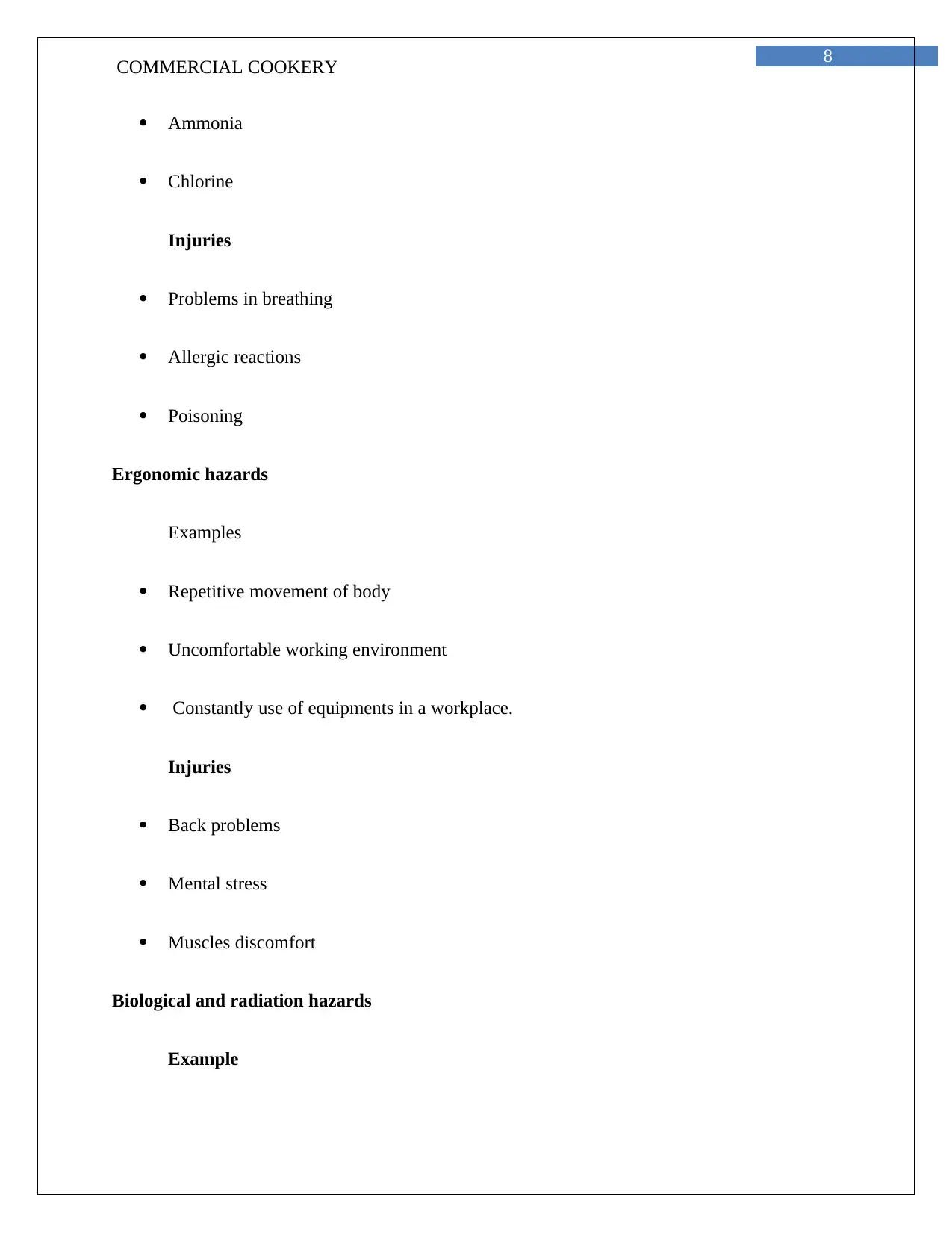
8
COMMERCIAL COOKERY
Ammonia
Chlorine
Injuries
Problems in breathing
Allergic reactions
Poisoning
Ergonomic hazards
Examples
Repetitive movement of body
Uncomfortable working environment
Constantly use of equipments in a workplace.
Injuries
Back problems
Mental stress
Muscles discomfort
Biological and radiation hazards
Example
COMMERCIAL COOKERY
Ammonia
Chlorine
Injuries
Problems in breathing
Allergic reactions
Poisoning
Ergonomic hazards
Examples
Repetitive movement of body
Uncomfortable working environment
Constantly use of equipments in a workplace.
Injuries
Back problems
Mental stress
Muscles discomfort
Biological and radiation hazards
Example
⊘ This is a preview!⊘
Do you want full access?
Subscribe today to unlock all pages.

Trusted by 1+ million students worldwide
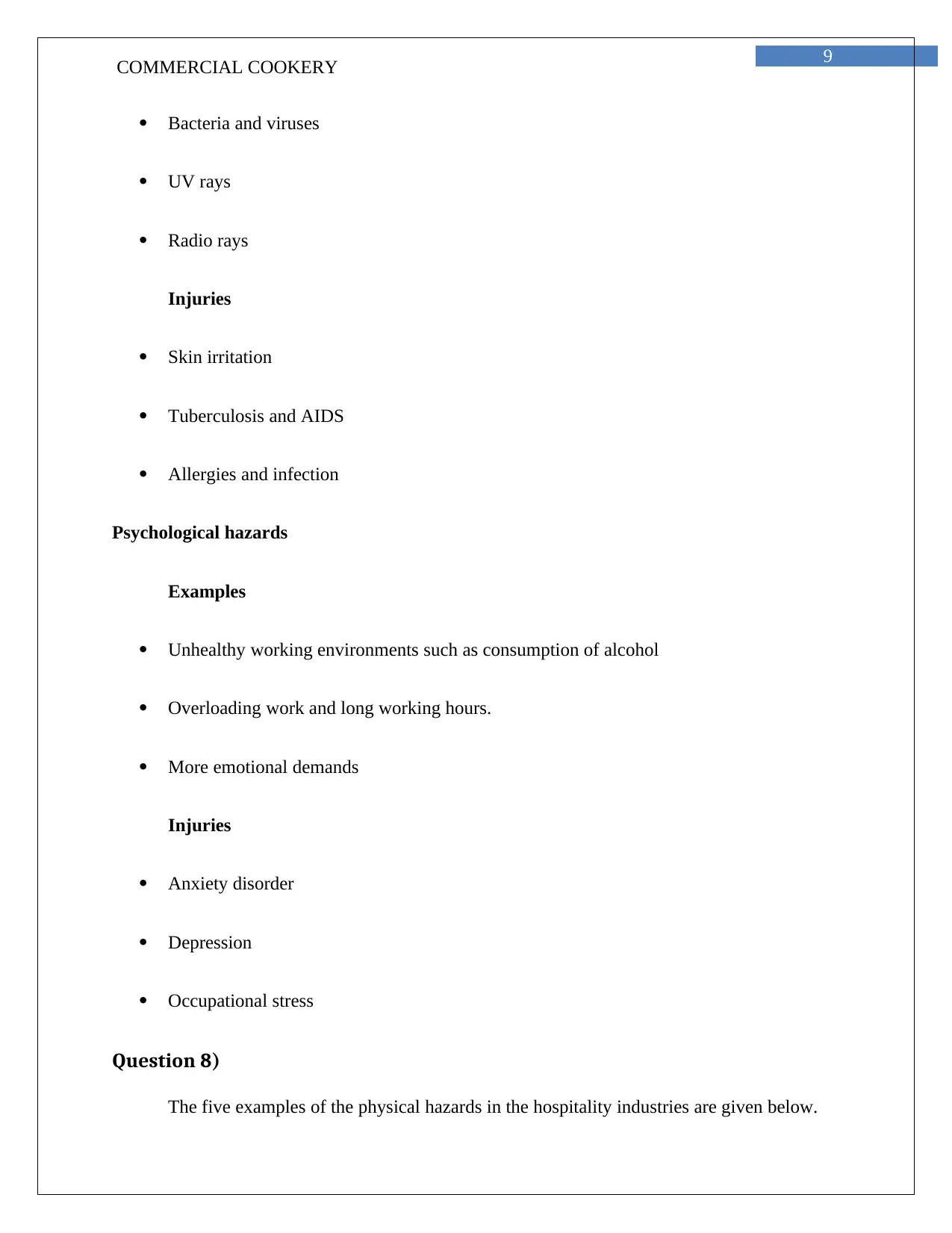
9
COMMERCIAL COOKERY
Bacteria and viruses
UV rays
Radio rays
Injuries
Skin irritation
Tuberculosis and AIDS
Allergies and infection
Psychological hazards
Examples
Unhealthy working environments such as consumption of alcohol
Overloading work and long working hours.
More emotional demands
Injuries
Anxiety disorder
Depression
Occupational stress
Question 8)
The five examples of the physical hazards in the hospitality industries are given below.
COMMERCIAL COOKERY
Bacteria and viruses
UV rays
Radio rays
Injuries
Skin irritation
Tuberculosis and AIDS
Allergies and infection
Psychological hazards
Examples
Unhealthy working environments such as consumption of alcohol
Overloading work and long working hours.
More emotional demands
Injuries
Anxiety disorder
Depression
Occupational stress
Question 8)
The five examples of the physical hazards in the hospitality industries are given below.
Paraphrase This Document
Need a fresh take? Get an instant paraphrase of this document with our AI Paraphraser
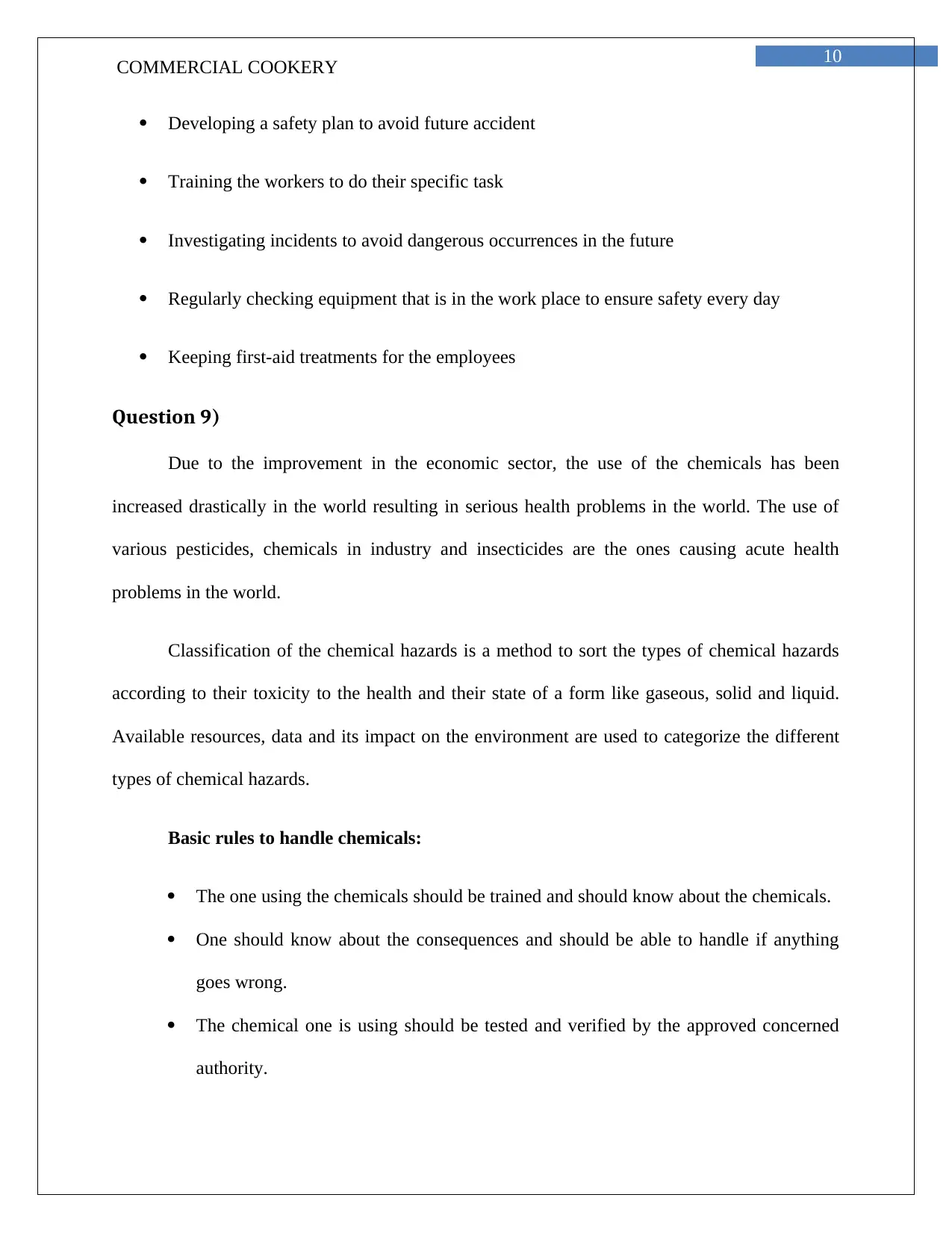
10
COMMERCIAL COOKERY
Developing a safety plan to avoid future accident
Training the workers to do their specific task
Investigating incidents to avoid dangerous occurrences in the future
Regularly checking equipment that is in the work place to ensure safety every day
Keeping first-aid treatments for the employees
Question 9)
Due to the improvement in the economic sector, the use of the chemicals has been
increased drastically in the world resulting in serious health problems in the world. The use of
various pesticides, chemicals in industry and insecticides are the ones causing acute health
problems in the world.
Classification of the chemical hazards is a method to sort the types of chemical hazards
according to their toxicity to the health and their state of a form like gaseous, solid and liquid.
Available resources, data and its impact on the environment are used to categorize the different
types of chemical hazards.
Basic rules to handle chemicals:
The one using the chemicals should be trained and should know about the chemicals.
One should know about the consequences and should be able to handle if anything
goes wrong.
The chemical one is using should be tested and verified by the approved concerned
authority.
COMMERCIAL COOKERY
Developing a safety plan to avoid future accident
Training the workers to do their specific task
Investigating incidents to avoid dangerous occurrences in the future
Regularly checking equipment that is in the work place to ensure safety every day
Keeping first-aid treatments for the employees
Question 9)
Due to the improvement in the economic sector, the use of the chemicals has been
increased drastically in the world resulting in serious health problems in the world. The use of
various pesticides, chemicals in industry and insecticides are the ones causing acute health
problems in the world.
Classification of the chemical hazards is a method to sort the types of chemical hazards
according to their toxicity to the health and their state of a form like gaseous, solid and liquid.
Available resources, data and its impact on the environment are used to categorize the different
types of chemical hazards.
Basic rules to handle chemicals:
The one using the chemicals should be trained and should know about the chemicals.
One should know about the consequences and should be able to handle if anything
goes wrong.
The chemical one is using should be tested and verified by the approved concerned
authority.
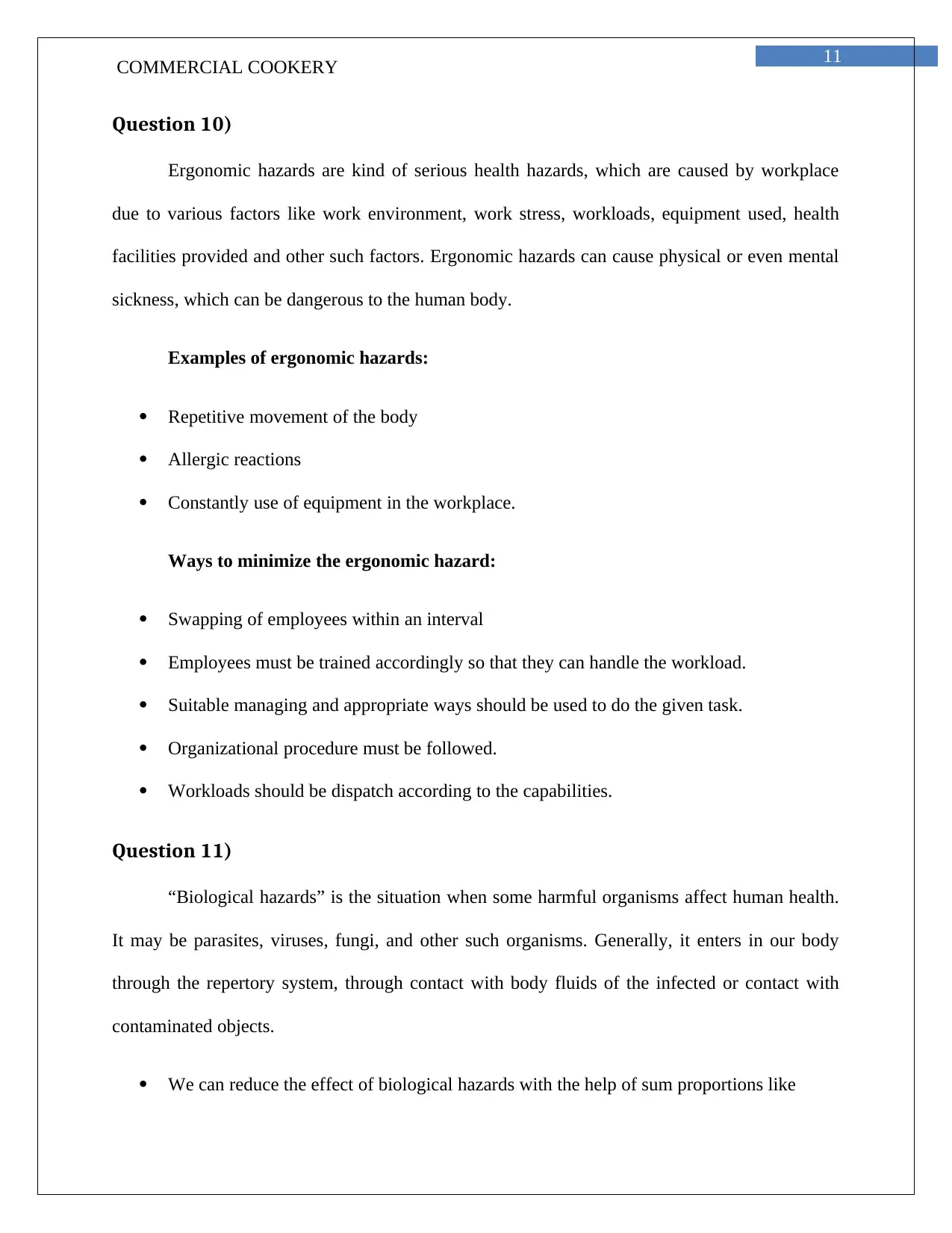
11
COMMERCIAL COOKERY
Question 10)
Ergonomic hazards are kind of serious health hazards, which are caused by workplace
due to various factors like work environment, work stress, workloads, equipment used, health
facilities provided and other such factors. Ergonomic hazards can cause physical or even mental
sickness, which can be dangerous to the human body.
Examples of ergonomic hazards:
Repetitive movement of the body
Allergic reactions
Constantly use of equipment in the workplace.
Ways to minimize the ergonomic hazard:
Swapping of employees within an interval
Employees must be trained accordingly so that they can handle the workload.
Suitable managing and appropriate ways should be used to do the given task.
Organizational procedure must be followed.
Workloads should be dispatch according to the capabilities.
Question 11)
“Biological hazards” is the situation when some harmful organisms affect human health.
It may be parasites, viruses, fungi, and other such organisms. Generally, it enters in our body
through the repertory system, through contact with body fluids of the infected or contact with
contaminated objects.
We can reduce the effect of biological hazards with the help of sum proportions like
COMMERCIAL COOKERY
Question 10)
Ergonomic hazards are kind of serious health hazards, which are caused by workplace
due to various factors like work environment, work stress, workloads, equipment used, health
facilities provided and other such factors. Ergonomic hazards can cause physical or even mental
sickness, which can be dangerous to the human body.
Examples of ergonomic hazards:
Repetitive movement of the body
Allergic reactions
Constantly use of equipment in the workplace.
Ways to minimize the ergonomic hazard:
Swapping of employees within an interval
Employees must be trained accordingly so that they can handle the workload.
Suitable managing and appropriate ways should be used to do the given task.
Organizational procedure must be followed.
Workloads should be dispatch according to the capabilities.
Question 11)
“Biological hazards” is the situation when some harmful organisms affect human health.
It may be parasites, viruses, fungi, and other such organisms. Generally, it enters in our body
through the repertory system, through contact with body fluids of the infected or contact with
contaminated objects.
We can reduce the effect of biological hazards with the help of sum proportions like
⊘ This is a preview!⊘
Do you want full access?
Subscribe today to unlock all pages.

Trusted by 1+ million students worldwide
1 out of 32
Related Documents
Your All-in-One AI-Powered Toolkit for Academic Success.
+13062052269
info@desklib.com
Available 24*7 on WhatsApp / Email
![[object Object]](/_next/static/media/star-bottom.7253800d.svg)
Unlock your academic potential
Copyright © 2020–2025 A2Z Services. All Rights Reserved. Developed and managed by ZUCOL.





